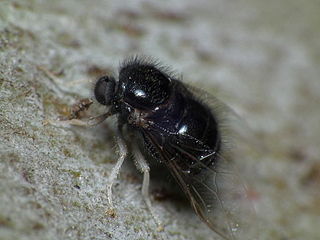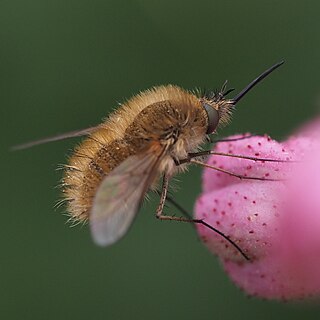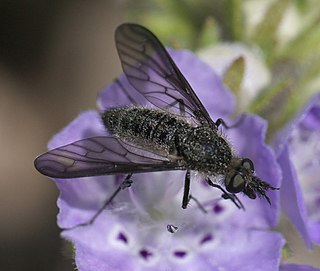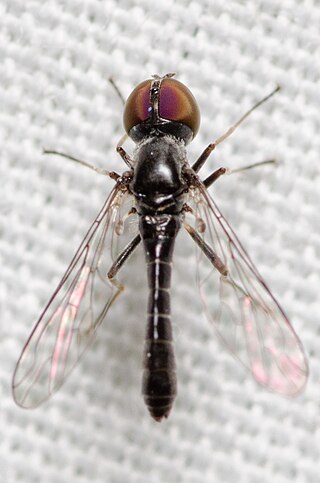
The Bombyliidae are a family of flies, commonly known as bee flies. Adults generally feed on nectar and pollen, some being important pollinators. Larvae are mostly parasitoids of other insects.

The Acroceridae are a small family of odd-looking flies. They have a hump-backed appearance with a strikingly small head, generally with a long proboscis for accessing nectar. They are rare and not widely known. The most frequently applied common names are small-headed flies or hunch-back flies. Many are bee or wasp mimics. Because they are parasitoids of spiders, they also are sometimes known as spider flies.

Bombylius major is a parasitic bee mimic fly. B. major is the most common type of fly within the Bombylius genus. The fly derives its name from its close resemblance to bumblebees and are often mistaken for them.

Bombylius canescens, is a species of bee-fly belonging to the family Bombyliidae.

Bombyliinae is a subfamily of bee flies in the family Bombyliidae. There are more than 70 genera in Bombyliinae.

Toxophorinae is a subfamily of bee flies in the family Bombyliidae. There are about 7 genera and more than 400 described species in Toxophorinae.

Eclimini is a tribe of bee flies in the family Bombyliidae. This tribe was formerly considered a subfamily of Bombyliidae, but was transferred to the subfamily Bombyliinae as a result of research published in 2019.

Phthiriinae is a subfamily of bee flies in the family Bombyliidae. There are about 11 genera and more than 120 described species in Phthiriinae.

Tomomyzinae is a subfamily of bee flies in the family Bombyliidae. There are at least 6 genera and more than 50 described species in Tomomyzinae.

Geminaria is a genus of bee flies.
Usiinae is a subfamily of bee flies in the family Bombyliidae. There are at least 3 genera and 180 described species in Usiinae.
Cythereinae is a subfamily of bee flies in the family Bombyliidae. There are about 19 genera and 150 species in Cythereinae.
Heterotropus is a genus of bee flies in the family Bombyliidae. It is the only genus in the subfamily Heterotropinae, which formerly contained at least four genera. There are more than 45 species in the genus Heterotropus.
Lomatiinae is a subfamily of bee flies in the family Bombyliidae. There are about 16 genera and at least 290 described species in Lomatiinae.
Antoniinae is a subfamily of bee flies in the family Bombyliidae. There are at least 4 genera and 20 described species in Antoniinae.
Crocidiinae is a subfamily of bee flies in the family Bombyliidae. There are about 8 genera and 50 described species in Crocidiinae.
Mariobezziinae is a subfamily of bee flies in the family Bombyliidae. There are about 10 genera and at least 50 described species in Mariobezziinae.
Xenoprosopa is a genus of bee flies in the family Bombyliidae, the sole genus of the subfamily Xenoprosopinae. The only described species in the genus is X. paradoxa Hesse, 1956.
Oniromyia is a genus of bee flies in the family Bombyliidae, the sole genus of the subfamily Oniromyiinae. There are at least two described species in Oniromyia.
Oligodranes is a genus of bee flies in the family Bombyliidae, the sole genus of the subfamily Oligodraninae.










